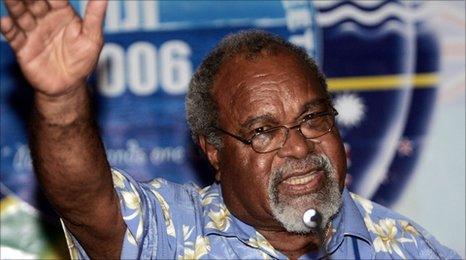Papua New Guinea profile - Timeline
- Published
A chronology of key events
50.000 BC - First settlers are thought to arrive on New Guinea from Asia.
5000 BC - Intensive agriculture develops in the New Guinea Highlands, apparently independently of outside influence.
1100-900 BC - Second wave of migrants from south-east Asia.
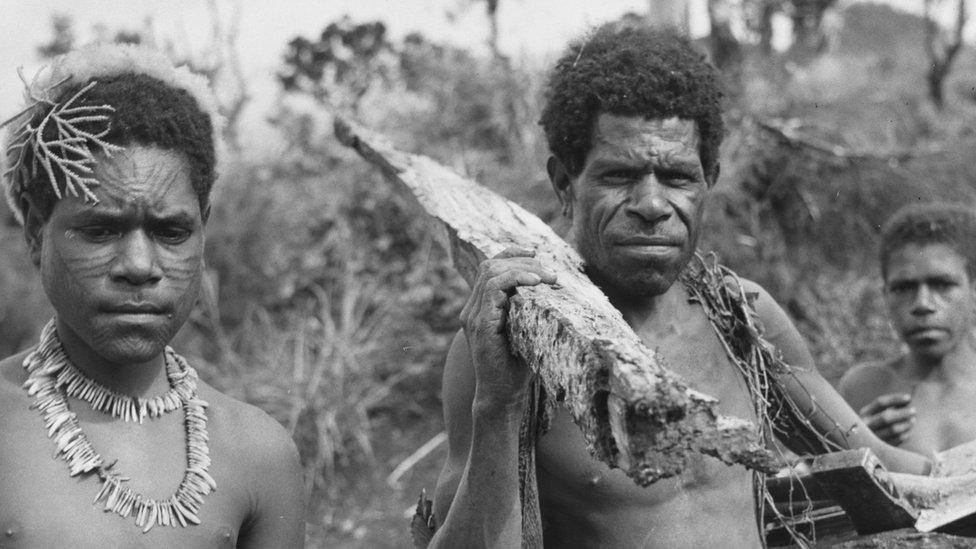
Papua New Guinea has more than 800 distinct languages
1526 - Portuguese sailor Jorge de Meneses is the first European visitor. He names one of the islands "ilhas dos Papuas" or "land of fuzzy-haired people".
1546 - Spanish explorer Inigo Ortiz de Retes names the other main island New Guinea because the islanders resemble the people of Guinea in Africa.
1800 - Substantial trade networks are active all over New Guinea, with the Kula ring, a ceremonial exchange system, being particularly extensive.
1860s - American and European whalers frequent the Bismarck Archipelago, with the Duke of York Islands becoming an important anchorage.

"Queen Emma", reputedly of Samoan royal lineage, arrived in 1878 to establish a business empire based on plantations. Her story was told in the mini series Emma: Queen of the South Seas
1873 - Methodist missionary George Brown opens a mission station on Duke of York Islands. From the Torres Strait, the London Missionary Society sends evangelists to the New Guinean south coast.
1873 - Captain John Moresby charts the south-east part of New Guinea and the archipelago, naming Port Moresby after his father.
Europeans, Australians take control
1884 - Britain establishes a protectorate, British New Guinea (BNG), over south-east New Guinea, while Germany annexes the northern part of New Guinea.
1888 - In BNG the Armed Native Constabulary is established and village constables are appointed.
1890s - Governor MacGregor and others make several exploratory expeditions around BNG.
1895 - Gold is found on the Mambare River. A gold rush leads to hostilities between locals and miners.

Britain annexed New Guinea in 1885
1906 - Control of British New Guinea transferred to the newly independent Commonwealth of Australia and renamed Territory of Papua.
1914 - Australian forces occupy German New Guinea during the First World War.
1921 - After the war the League of Nations grants Australia a mandate to run German New Guinea. This new Mandated Territory of New Guinea is governed totally separately from the Territory of Papua.
1920s - A major gold find along the Bulolo River prompts another gold rush.
1933 - Gold-prospectors lead expeditions into the highlands. Here they find more than a million people living in fertile mountain valleys, their way of life apparently unchanged since the Stone Age.
Second World War
1942 - Japanese forces occupy parts of both territories.
1942-43 - Allied victories in the battles of Milne Bay, along the Kokoda Trail and around Buna and Gona becomes the turning point of the Pacific War, forcing the Japanese to retreat.
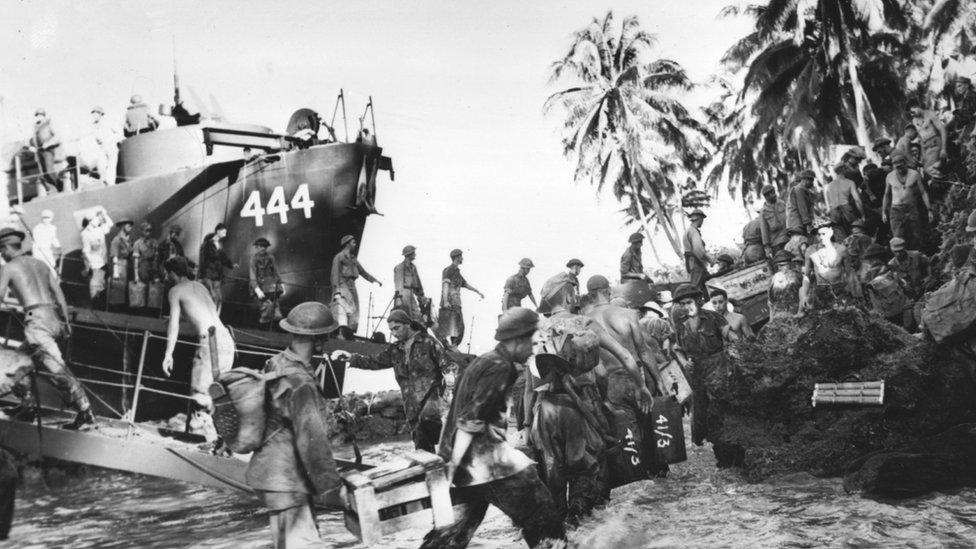
Troops from New Zealand, pictured landing on Green Island, played a part in forcing a Japanese retreat in the Pacific
1949 July - Australia establishes a joint administration over both territories called the Territory of Papua and New Guinea.
1951 November - A 28-member Legislative Council established by Australia.
1954 June - Aerial survey reveals several previously undiscovered highland valleys inhabited by up to 100,000 people.
1961 March - First elections involving indigenous population.
West New Guinea transferred to Indonesia
1963 May - UN transfers control of West New Guinea to Indonesia. Today this region is called West Papua.
1964 June - A 64-member House of Assembly replaces Legislative Council and for the first time indigenous representatives are elected to the majority of seats in the legislature.
1971 July - Renamed Papua New Guinea (PNG).

Michael Somare is described as the nation's founding father
1973 February - Indonesia and PNG agree position of Irian Jaya border.
1973 December - Granted self-government. Michael Somare, chief minister in an interim coalition government, is sworn in as head of the governing Executive Council.
1975 April - New currency, the kina, replaces the Australian dollar.
Independence
1975 16 September - Attains full independence from Australia. Sir Michael Somare becomes PM.
1975 - Bougainville provincial government votes to secede from PNG. Somare's government retaliates by suspending the provincial government and withholding payments to the province.
1977 June-July - First parliamentary elections since independence.
Bougainville separatist struggle
1989 April/May - Separatist rebels on Bougainville begin prolonged armed struggle against the government. Secessionist, Francis Ona, proclaims "a republic of Bougainville". The recently-formed Bougainville Revolutionary Army (BRA), anxious about environmental destruction and unhappy that profits are leaving the island, forces the closure of the Australian-owned Panguna copper mine.
1994 - PM Sir Julius Chan signs agreement with several Bougainville secessionist leaders which provides a transitional administration in Bougainville. Bougainville Revolutionary Army leaders are not signatories; they continue to fight for full independence.
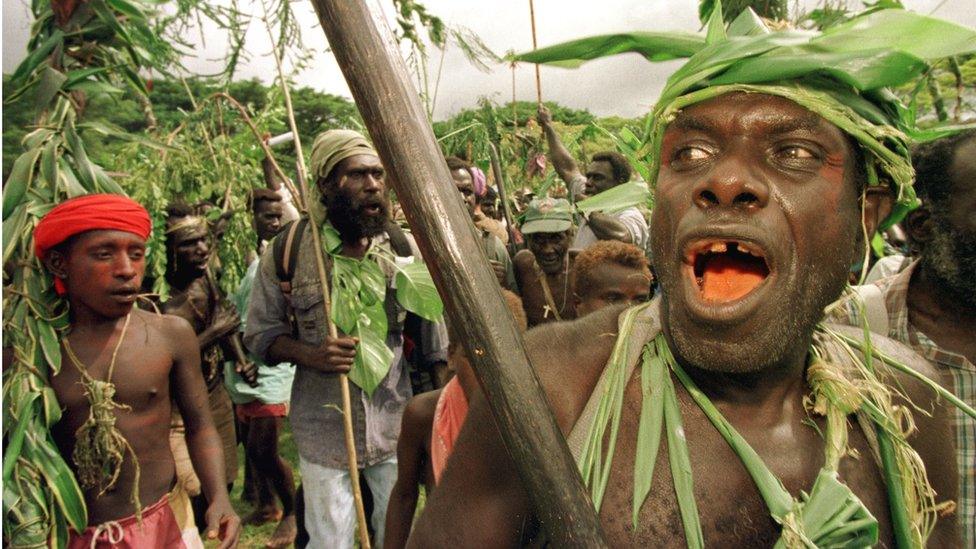
Guerillas from the Bougainville Revolutionary Army (BRA) arrive at the signing of the ceasefire deal that ended a decade of civil war
1995 April - The Bougainville Transitional Government is sworn in under leadership of Theodore Miriong. The three seats reserved for the BRA remain vacant.
1996 - Theodore Miriong is assassinated at his home in south-west Bougainville. He is replaced by Gerard Sinato.
1997 February-March - Government hires mercenaries from Sandline International to support government troops in Bougainville, sparking an army mutiny and civil unrest. Prime Minister Chan is forced to resign.
1997 September - The government declares a national state of disaster following a prolonged drought thought to have been caused by the El Nino weather phenomenon. Over 1,000 people are killed and a further 1.2 million are put at risk of starvation.
Truce
1997 October - Burnham Truce marks the end of the decade-old armed struggle by Bougainville separatists.
1997 December - Countries in the region establish the Truce Monitoring Group to oversee compliance with the Burnham Truce until 30 April 1998 when a ceasefire is to be signed. The New Zealand-led group also comprises troops from Australia, Fiji and Vanuatu. All of them are unarmed.
1998 April - Permanent ceasefire signed in Bougainville by government representatives and secessionist leaders. Australian-led Peace Monitoring Group takes over from Truce Monitoring Group.
1998 July - Three tsunamis - gigantic waves generated by earthquakes - hit the north-west coast obliterating villages and killing 3,000 people.
1998 August - United Nations establishes the UN Political Office in Bougainville at the request of the PNG government.
1999 1 January - Bougainville Reconciliation Government replaces the Bougainville Transitional Government. Former rebel leader Joseph Kabui and Gerard Sinato are nominated as co-leaders.
1999 May - Joseph Kabui elected president of the Bougainville People's Congress.
1999 December - John Momis sworn in as governor of Bougainville.
2000 November - Authorities say all 1,000 inhabitants of the Duke of York atoll will have to be relocated because the island is slowly sinking due to global warming.
2001 August - Bougainville Peace Agreement, guaranteeing a referendum in 10 to 15 years on Bougainville's future political status, is signed in Arawa.
2002 August - Sir Michael Somare elected as prime minister for a third time, after a violent and chaotic election.
2004 August - Australia deploys police to help fight rampant crime.
2005 May - Australia withdraws its police officers after the PNG Supreme Court rules that their deployment is unconstitutional.
Bougainville islanders elect their first autonomous government. Former separatist rebel Joseph Kabui becomes president.
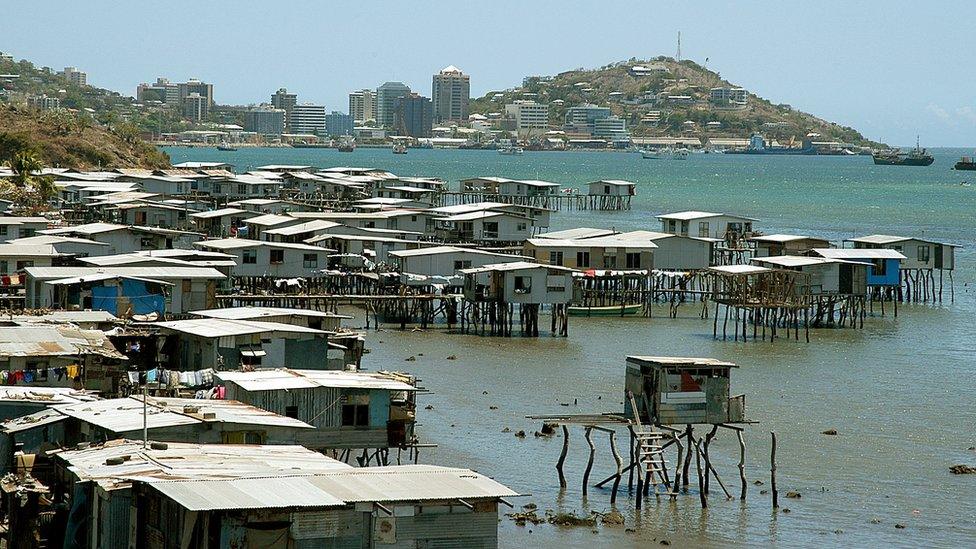
Port Moresby is the capital of Papua New Guinea
2007 May - Parliament passes a law to allow casinos and online gambling. It is hoped that the activity could boost the economy.
2007 August - Sir Michael Somare re-elected as premier.
2007 November - Cyclone Guba causes flooding which kills 163 and leaves more than 13,000 displaced in Oro and Milne provinces.
2008 June - Bougainville President Joseph Kabui dies.
2008 December - Former rebel James Tanis elected autonomous president of Bougainville.
2009 December - China signs a deal to import liquified natural gas from Papua New Guinea.
Political crisis
2011 April-June - Prime Minister Michael Somare is suspended for two weeks over charges of misconduct dating back 20 years. He extends his absence for medical reasons and undergoes heart surgery in Singapore. In June, his family announces his retirement from the premiership and from politics.
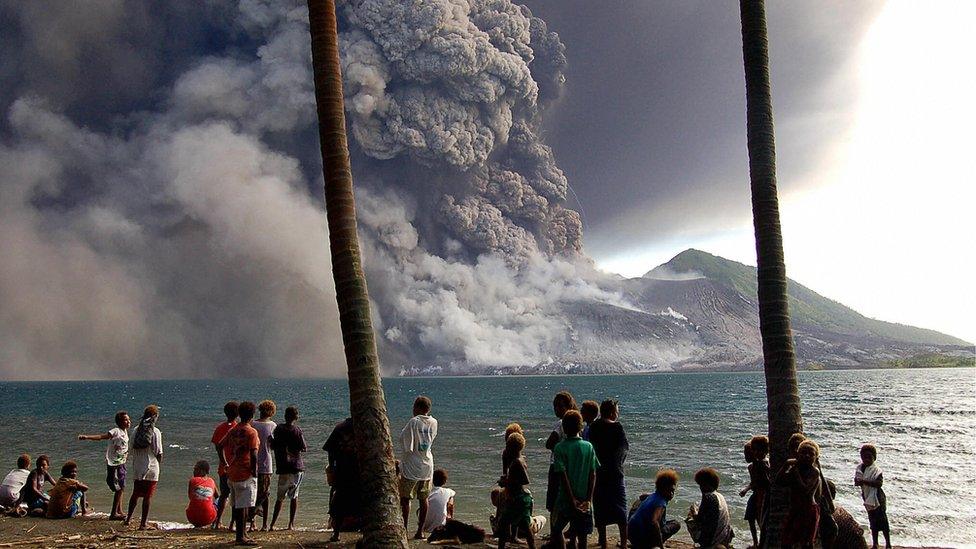
Papua New Guinea lies on the "Ring of Fire", an area prone to volcanic eruptions
2011 August - Parliament elects Peter O'Neill as acting prime minister, replacing acting prime minister Sam Abal, who takes legal action against the move.
2011 September - Michael Somare returns from Singapore and claims that he is still the prime minister, saying that he did not retire voluntarily.
2011 December - Standoff between Peter O'Neill and Michael Somare continues, with both running parallel administrations. Governor-General Michael Ogio recognises the election of Peter O'Neill, who has has the backing of a majority of parliamentary deputies.
2012 January - Mutinous soldiers demanding the reinstatement of Sir Michael Somare as PM briefly seize the military headquarters in Port Moresby.
2012 June - Rival prime ministers Peter O'Neill and Sir Michael Somare contest parliamentary elections, hoping that the results will decide who is in charge.
2012 July-August - Sir Michael Somare accepts the defeat of his party in the June poll and backs Peter O'Neill's bid to form a government. Parliament endorses Mr O'Neill as PM in August.
2013 January - PM Peter O'Neill bans ministers and other government officials from travelling overseas for work without his personal approval.
2013 May - Following a series of brutal public killings, the controversial 1971 Sorcery Act - which acknowledged the accusation of sorcery as a plausible defence in murder cases - is repealed. However, parliament also extends the range of offences for which the death penalty can be applied, to the dismay of human rights organisations.
2013 July - Papua New Guinea agrees to provide offshore processing for asylum seekers who reach Australia by boat. Under the deal, asylum seekers whose refugee claims are upheld will be settled in PNG. Australia pledges to grant Papua New Guinea generous aid in return, and the processing centre on PNG's Manus Island will be significantly expanded to hold up to 3,000 people.
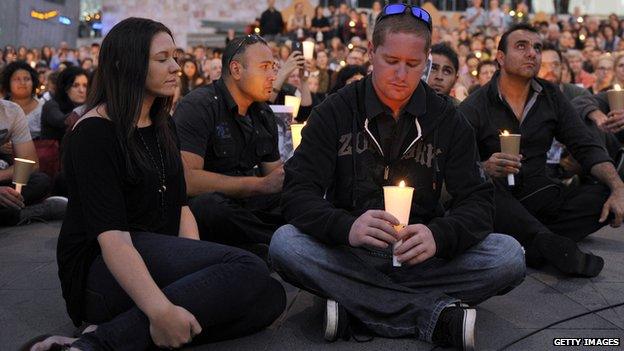
Hundreds of people in Australia attended vigils in support of asylum seekers after an Iranian refugee died in a detention centre on Manus Island in 2014
2013 September - Two guides are killed when a group of Australian and New Zealand hikers and their local porters are attacked by machete-wielding robbers on PNG's Black Cat Track.
2014 February - Violence at Australia's immigration detention centre on PNG's Manus Island leaves one asylum seeker dead and 77 injured.
2014 March - Papua New Guinea's Supreme Court begins a human rights inquiry into Australia's immigration detention centre on Manus Island. The probe will assess whether the centre's conditions meet human rights requirements under PNG's constitution.
2014 April - Paul Tiensten, a former senior minister and current MP, is sentenced to nine years imprisonment for misappropriating millions of dollars of public funds. The sentence is the most severe yet in PNG for a corrupt public official.
2014 June - An arrest warrant is issued for Prime Minister Peter O'Neill after the national anti-corruption watchdog accuses him of authorising fraudulent payments by the government to a Port Moresby law firm. Mr O'Neill challenges the warrant in multiple court cases.
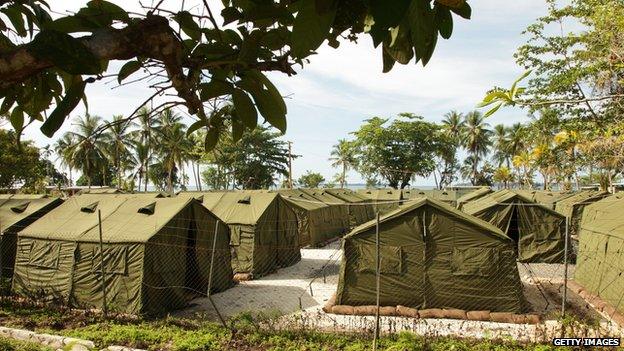
Australia's refugee detention centre on Manus Island has been controversial
2014 June - Prime Minister O'Neill disbands the country's main anti-corruption body, Taskforce Sweep.
2014 November - Prime Minister O'Neill is referred to a tribunal of judges over allegations of misconduct in office relating to a $1.3 billion loan.
2015 January - Government denies reports that protests at an Australian immigration centre on Manus Island turned violent after 400 detainees reportedly went on hunger strike.
2015 October - Government says it will begin resettling refugees being held in the country in Australian-run detention centres.
2016 February - Police shoot dead 12 prisoners following a jail break by over 90 inmates at a prison in the city of Lae.
2016 April - Government says it will close the Australian detention centre on Manus Island after the Supreme Court rules that detaining asylum seekers at the facility is unconstitutional.
2016 July - Prime Minister Peter O'Neill survives no-confidence vote in parliament over corruption allegations following weeks of protests calling for his resignation.
2016 November - Australia says refugees held in detention centres in Papua New Guinea and Nauru will be resettled in the United States in a "one-off deal".
2016 December - China agrees to spend nearly 4bn US dollars to build a giant industrial park in Papua New Guinea.
2017 August - Prime Minister O'Neill wins another term in elections.
2017 November - Australia closes a detention centre in Papua New Guinea, but hundreds of asylum seekers refuse to move.
- Published28 June 2011
